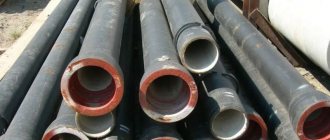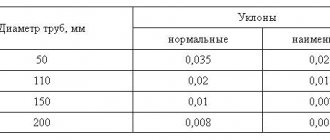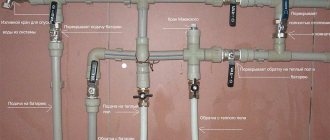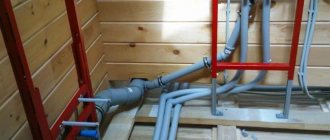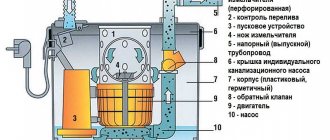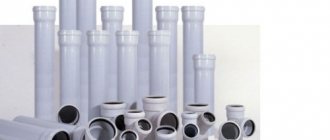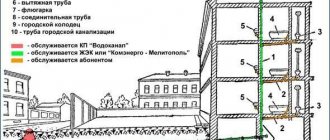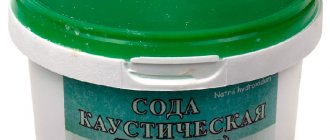The stable operation of the sewer system of a private house during the cold season depends on how to insulate its constituent elements. Next, we’ll talk in more detail about how to equip a cesspool so that it does not freeze in winter. Particular attention should be paid to the upper part of the well. Wastewater does not freeze even in the most severe frosts due to the activity of bacteria that cause fermentation. The upper part of the cesspool is less populated by these bacteria, so those elements of the septic tank that are located in the zone of soil freezing and also protrude above the ground require insulation.
You can insulate the drainage pit using the following materials:
- foam boards with a thickness not exceeding 100 mm;
- a layer of expanded clay no more than 300 mm thick;
- mineral wool with waterproofing.
Do-it-yourself insulation of a drain pit
The stable operation of the sewer system of a private house during the cold season depends on how to insulate its constituent elements. Next, we’ll talk in more detail about how to equip a cesspool so that it does not freeze in winter. Particular attention should be paid to the upper part of the well. Wastewater does not freeze even in the most severe frosts due to the activity of bacteria that cause fermentation. The upper part of the cesspool is less populated by these bacteria, so those elements of the septic tank that are located in the zone of soil freezing and also protrude above the ground require insulation.
You can insulate the drainage pit using the following materials:
- foam boards with a thickness not exceeding 100 mm;
- a layer of expanded clay no more than 300 mm thick;
- mineral wool with waterproofing.
Defrosting by open fire
Most defrosting methods are either not very effective or quite dangerous.
The use of open fire falls into the second category. In addition, in some cases, it requires a lot of time from you and is only suitable if the pipes and body of the cesspool are made of infusible materials (brick, concrete, metal), and flammable mixtures are not poured into it.
If the pit is not very frozen, and there is an even layer of ice on the surface of the waste, you need to open its hatch and place hay, old rags, in general, everything that burns easily and comes to hand. All that remains is to add a little flammable substance, for example, thinner or gasoline, and start a fire inside the pit. We remind you once again that this method is completely unsuitable if the pit or pipes adjacent to it are made of plastic.
You cannot leave an open fire unattended, and you also cannot close the hatch. You must remain near the container at all times, monitor the situation, and, if necessary, pour water on the fire. On average, it takes several hours to defrost a pit using fire.
If this does not help, you will have to warm up the body of the waste collection container. To do this, it will have to be freed a little from the soil, and this is quite difficult to do, especially in winter. As a result, you need to dig out about half of the entire container.
The edges of the soil are covered with metal plates, and everything that burns easily is again placed in the formed funnel, in the middle of which is the upper part of the pit. In this case, you can even use firewood and build a full-fledged fire. This defrosting will take you 2-3 hours, and all this time you need to maintain the fire and control the degree of combustion.
If there is still a lot of time left until the end of the winter season, it is best not to dig the hole again. Most likely, you will have to freeze it this way more than once.
Cesspools with overflow mechanism
Another deeper septic tank is dug next to the cesspool. Its walls are reinforced with reinforced concrete rings, and the bottom is left earthen. Through holes in the upper rings, the pits are connected by overflow pipes. The pipes should be laid at a distance of at least 500 mm from the soil surface, that is, below the freezing zone. If the region has very severe winters, then this figure can be increased to 800 mm.
A septic tank made of two wells is the optimal solution to the issue of sewerage insulation.
Insulation of the drain pit using polystyrene
One of the most common technologies in the field of thermal insulation of a wide variety of objects is polystyrene insulation. This method is also suitable for a cesspool. It is especially convenient that today polystyrene can be purchased not only in the form of flat slabs, but also in the form of a “shell” - half rings. In addition, you can always choose the required thickness and diameter.
Insulation begins with surrounding the cesspool with a trench at least 1.5 meters deep. Then pre-prepared polystyrene half-rings are installed in this trench. The insulation is attached to the walls of the well using a tongue and groove mechanism, after which the trench is buried. The pit cover must also be carefully insulated.
A significant advantage of this method of insulation is that if you need to clean or repair the drainage pit, the polystyrene “shell” can be easily dismantled and, upon completion of all work, returned to its place.
Effective sewer insulation: we save not only the pit, but also the pipes from frost
How to insulate not only the drainage pit, but also the communications leading to it, that is, approach the problem of thermal insulation of the sewer system in a comprehensive manner? Of course, the ideal solution to the problem of freezing sewer pipes is to lay them below the ground freezing level. If this is not possible, the pipeline should be carefully insulated. Some difficulties always arise with pipes at the entrance to the room and with those sections of the sewer system that pass through unheated rooms. In these cases, it is advisable to use heating with an electric cable with a power of 10 W. The cable is wound around the sewer pipe at a certain frequency. When connected to the electrical network, the wire heats up, warming the pipe, and therefore the liquid in it. Thus, the possibility of pipe freezing is simply eliminated.
It is recommended to use a generator as a backup power source.
Flaws
The only disadvantage of this insulation method is a significant increase in energy costs. On the other hand, severe frosts last 1-2 months, and heating already frozen pipes will cost you much more. In addition, it is possible to wrap electric wires around only the most problematic areas of sewer pipes. Difficulties in preventing pipes insulated in this way from freezing can also arise when there are power outages. In this case, an autonomous generator will save the situation.
Thus, the insulation of the sewer system of a private house should be approached comprehensively. Insulating a cesspool means solving only one of a number of tasks. By taking measures to insulate sewer pipes, you can be absolutely sure of the stable operation of the entire system even in the most severe frosts.
Electrical cable
This is not exactly the kind of cable that we are used to seeing for outdoor work. This is a metal wire without insulation and with increased resistance.
When an electric current passes through it, it converts it into heat energy. So, when laying such a cable underground, along with drainage pipes, it helps to warm them up in winter.
Active heating using heating elements has its own characteristics and positive aspects:
Heating cable device diagram
- protection of open sewage system;
- heating of communications in boxes, tunnels, channels;
- thermal insulation of collectors installed in the ground.
There are two types of heating elements used when laying communications to heat them:
- resistive - regardless of the time of year or external conditions, it constantly warms up. When using this element, the heating system must be constantly monitored;
- self-regulating – does not require constant monitoring, as it is able to independently assess external conditions and adapt to them.
Scheme of sewer insulation with heating cable
Heating cable design option
This method has a significant disadvantage - dependence on the availability of electricity and good voltage in the network; in the event of an accident - which often happens - there is the possibility of defrosting all communication systems during cold weather. Insulation of drainage systems using electrical cables requires the following preparatory measures:
- Select areas for thermal insulation.
- Calculate the amount of material - in this case cable.
- Decide which heating method will be preferable for you, self-regulating or resistive.
Calculation table for pipe insulation
Which sewerage elements are most vulnerable to frost ↑
First of all, it is necessary to understand the principle of operation of external sewage systems. Liquid household waste, having passed through an internal pipeline network, enters a pipe that is located underground and connects the house with a cesspool. Due to the fact that the outer pipe is mounted at a certain slope, the wastewater is drained into a pit, where it is subjected to a recycling process. Subsequently, the concrete waste is removed using sewage disposal equipment.
The principle of operation of the external sewer system
Since a significant part of the wastewater is water, at sub-zero temperatures it quickly crystallizes. All elements of the system located above the soil freezing level are subject to this effect.
Note. The larger the diameter of the external pipeline, the less likely it is that an ice plug will form in it. However, in particularly harsh conditions, even a large-diameter pipe is not a guarantee of stable sewage functionality.
With high intensity of operation of the sewer system, the local treatment plant quickly fills up. If the cesspool is not insulated, the upper surface of the drains will become covered with an ice crust, which will block the operation of the sewer system throughout the house. Therefore, even at the installation stage, care should be taken to ensure reliable thermal insulation of such a structure.
Frozen sewer drains
Installation location
At first glance, it may seem that there will be no problems with the installation location of the cesspool, but this is far from the case. For these structures there are certain rules that must be followed. Firstly, you cannot place a pit near houses, garages, gazebos and other buildings, closer than five meters. If there are wells, springs and other sources of drinking water on the site, then the minimum distance should be thirty meters. All these rules are very important, so the location should be chosen very carefully.
Options for insulating a cesspool ↑
The size of the pit for the cesspool must be calculated in such a way that at least a third of the container is located below the soil freezing line. The rest of the structure on the sides and top can be insulated with various thermal insulation materials, among which the most popular are:
- expanded clay;
- mineral wool;
- expanded polystyrene.
Budget insulation with expanded clay ↑
When deciding how to insulate a cesspool in a private house, one usually proceeds from the cost of materials. One of the most budget-friendly options is the use of expanded clay.
For your information. Expanded clay is a porous material that is produced by firing clay and shale. Due to its low weight and excellent thermal insulation properties, it is widely used in various fields of construction.
To insulate the treatment plant, expanded clay is poured between the wall of the structure and the slope of the pit, as well as on top of the ceiling. To achieve the desired effect, the layer thickness must be at least 200 mm.
Expanded clay - affordable insulation for wastewater treatment plants
Thermal insulation with mineral wool ↑
The use of mineral wool as an insulation material can also be considered a budget option, although this insulation is somewhat more expensive than expanded clay. The advantage of mineral wool is its low thermal conductivity with a small layer thickness.
Note. Dust from mineral wool can cause irritation to the mucous membranes and skin, so protective clothing should be used during installation.
When deciding to insulate a cesspool with this material, you should definitely take into account one of its features. The fact is that the thermal conductivity of mineral wool increases significantly if it is exposed to moisture. Therefore, after laying the mineral wool, it is necessary to place a layer of waterproofing on top, for example from roofing felt.
Insulation of a cesspool with mineral wool
Application of polystyrene foam ↑
Expanded polystyrene (or polystyrene foam) is a thermal insulator with one of the lowest thermal conductivity values. If for mineral wool this characteristic ranges from 0.07-0.08 W/m·°C, then for polystyrene foam it is two times lower - 0.04 W/m·°C.
Advice. To insulate a cesspool, it is better to use extruded polystyrene foam. It costs more than regular foam, but has a higher density, which allows it to successfully cope with ground loads.
Flat sheets are used to insulate smooth walls and the top floor, and shell-shaped insulation can be used for a round structure. The material is attached to the surface using special adhesives. An important property of expanded polystyrene is minimal water absorption, so additional waterproofing is not required in this case.
Even one or two layers of polystyrene foam may be enough to protect the cesspool from freezing
How to insulate a sewer pipe ↑
There are several ways to insulate sewer pipes that connect to a cesspool:
- Mark the pipeline below the ground freezing level.
- Use thermal insulation materials.
- Apply heating cable.
Despite the seemingly obvious advantages, the first option is rarely used in private settings. This is due to the complexity of the land and the specifics of sewerage work. It must be taken into account that the sewer pipe is laid with a certain slope, so the deepening of the cesspool must also be significant. If the treatment plant is located too deep, firstly, it significantly increases the volume of excavation work, and secondly, it complicates the maintenance of the pit, since most sewage disposal machines are capable of collecting wastewater from a depth of no more than 4 m.
The most popular solution for insulating sewer pipes is the use of additional thermal insulation. As insulation, you can use the same materials that are used to insulate a cesspool and were described above.
A progressive option is the use of active insulation - a heating cable. Its advantage is the ability to place the pipe at a depth of only 0.5 m. The disadvantage of this method is its energy dependence.
Advice. It is recommended to use a heating cable with an automatic control system, which itself controls the heating power depending on the external temperature. This way you can significantly reduce energy consumption.
A modern option for insulating a sewer pipe
Installation
It is more convenient to carry out work with ready-made forms of insulation for the 110th sewer pipe. This is the so-called shell. It may consist of more than two parts. The edges are formed rectangular, with an overlapping projection or with a groove and tongue. There is also a sample with a cavity for a heating cable.
Here you need to select the desired internal diameter of the product, which has a longitudinal cut. That is, insulation of external sewer pipes is carried out by putting on a heat-insulating jacket. Next, it is enough to tighten it with tape, clamps or staples, glue it or cover it with additional moisture insulation.
Molded insulation is made from the following materials:
- Styrofoam;
- expanded polystyrene;
- polyurethane foam;
- foamed polyethylene;
- foam rubber.
Foamed rubber shell Source ad-cd.net
The sewage system is wrapped with rolled mineral wool without forming overlaps, but with the edges tightly adjacent to each other. This approach is relevant for large-scale projects due to the relatively low cost of the material. In the private sector, it is more convenient to work with metallized casings.
The cesspool is frozen: what to do ↑
If for some reason it was not possible to insulate a cesspool in a private house, in winter there is a high probability of it freezing. In order not to be left without a functioning sewerage system, emergency measures are taken:
- Boiling water and soda ash. If the ice is thin, it is quite possible to defrost it with boiling water. The effect can be increased by adding soda ash.
- Reagents for melting ice. The composition of such substances includes sodium, magnesium and calcium salts, which quickly react with water, forming a liquid solution. It is worth noting that the freezing point of such a solution is much lower than that of water.
- Gas burner or blowtorch. You can melt a layer of ice using an open flame. However, in this case, you must be extremely careful not to damage PVC pipes and other elements of the system that are easily melted.
A more complex problem is the formation of an ice plug in a sewer pipe. If boiling water or reagents do not clear the blockage, it is better to seek help from specialists. Independent attempts can lead to damage to the pipe and loss of its tightness.
One of the professional ways to defrost sewers is to use a steam generator
For continuous operation of the sewer system of a private house in winter, it is very important to insulate the cesspool and sewer pipes. If there is no free time or desire to do such work, it is better to entrust the thermal insulation of the treatment plant to professionals. Having done high-quality insulation once, you will forever forget about the problem of freezing home sewerage.
Materials for external insulation
Let's consider how to insulate a sewer pipe in the ground. Here you need to build on the operating conditions of the materials. This is seasonal soil movement, temperature and humidity changes. That is, the general requirements that thermal insulation must meet will be:
- low thermal conductivity (the colder the region, the lower the coefficient);
- sufficient flexibility or rigidity to form a winding or construct an insulated box (the integrity of the materials must be maintained);
- resistance to variable operating conditions (temperature, humidity, load);
- inertness to fungi, mold, bacteria, chemical reagents;
- long service life.
Selection criteria also include ease of installation work. For open areas, it is important that the insulation is resistant to ultraviolet rays. For circuits immersed in the ground, materials are being considered that can be used to create a hermetic thermal protection.
Elimination of unpleasant odor
The stench accompanies almost all street toilets and cesspools. If ventilation is connected, the unpleasant odor spreads less throughout the area, but does not disappear. To combat this nuisance, you must first clear the drain of sludge, which is the main cause of the stench, and then carry out preventive work.
- Good reviews about microbiological means for cleaning wastewater tanks. They not only effectively combat sludge and solid parts, but also completely eliminate odor. This option is not suitable for cleaning pits with soapy or chlorinated wastewater;
Microbiological odor control agent
Video on the topic:
Winter care
For owners of a private home, it is very important to properly prepare the cesspool for winter. If you did not take care of insulating the walls, then you can try to protect the tank from freezing from above. To do this, the lid and some space above the drain are covered with agrofibre or foam.
Insulation of the tank with mineral wool
Some home craftsmen advise covering the hole with a clay box. This option is good if cleaning and inspection for cosmetic or technical problems were carried out in the fall. A formwork is made on top of the lid, which is filled with clay. A sarcophagus is formed that does not let cold air inside.
If the cesspool is frozen, there are only two options for what you can do: try to warm it up yourself using a step-down transformer or use the services of professionals. If you have not previously heated pipes using electrical conductors, we do not recommend trying to use a welder as a heater. It may be dangerous.
Instructions for heating a metal cesspool:
- The exit pipe from the house is tightly wrapped with a conductor. The second end (directly near the entrance to the waste tank) is connected to the phase. Such a system does not need grounding, because the residual current goes into the ground from the high conductivity of the earth around the pipe;
- If there is a voltage drop when the heating wire is connected to the network, an overload occurs. This means that the ground absorbs a large amount of current. There is no way to get rid of this problem; it is necessary to stop the heating process.
The second option is to directly heat frozen fecal matter using a burner. Not the most pleasant, but quite effective. If the pit is small, then it makes sense to try to warm it up manually.
Insulation of a cesspool
A cesspool is the most popular option for arranging a sewer system for a country house or cottage. The comfort of residents directly depends on the quality of functioning of the waste tank. If in summer owners are forced to deal with the problem of unpleasant odor from the cesspool, then in winter a serious problem is the freezing of the sewage system, which leads to its complete unsuitability.
At low temperatures, not the entire cesspool freezes, but only its upper part. This is due to the fact that below there are active microorganisms that live in the ground, wander, and feed on waste. The temperature at the bottom of the pit is slightly higher.
Insulation of a cesspool
Hermetic tanks require special attention. Liquid accumulates inside, there is no air access, so bacteria die in such conditions. If the top of the pit freezes, then over time the bottom will also freeze. Sewage tanks made of concrete rings, slightly elevated above the ground, are also subject to freezing. The part that is not in the ground does not receive soil heat, and therefore freezes much faster than holes that are completely located in the ground.
Heat-insulating box for sewerage insulation
This is the laying of a drainage main on the surface of the earth, provided that it is impossible to lay pipes in the ground. In permafrost conditions this is very problematic and labor-intensive. In addition, communications can be damaged by moving soil, and some negative factors may arise in the frozen layer of earth:
- Sewerage is a source of constant heat, with liquid at a positive temperature.
- Not all thermal insulation can prevent heat exchange between communications and soil.
- This contributes to the thawing of the soil around the ground, and the formation of a swampy area.
Diagram of the thermal insulation box
As a result, the soil begins to subsidence, it becomes wet and heavy. The load on the collector increases significantly, and there is a high probability of pipe damage at the seams. In such situations, sewerage is laid in boxes, wooden and concrete boxes. These structures protect communications from frost, since there is thermal insulation material inside the boxes:
- Styrofoam;
- expanded clay;
- isover;
- glass wool
An example of a thermal insulation device made of foam plastic.
Also, when installing externally, do not forget about the technological slope, but in this situation it is not always possible to arrange such a slope, so a fecal pump is installed on the collector. This type of insulation is often installed in permafrost zones, during which a pit is dug into which a box is installed and a drainage system is laid. The pipes are wrapped with heat-insulating material, the top of the box is closed with a lid and covered with earth.
Why do you need to insulate a cesspool?
Very often, in the process of arranging a sewer system, owners do not understand the role of insulation of the cesspool and miss this point, which then negatively affects the functioning and durability of the structure.
Freezing of the drain tank causes the following problems:
Insulation work is best carried out during the construction of the sewer system. If this has not been done, then thermal insulation can be carried out later, however, you will have to make every effort, and the costs will increase significantly. It is necessary to insulate not only the cesspool itself, but also the drain pipes, because they also freeze at low temperatures.
Insulation work during the construction of the sewer system
You can hear the opinion that the sewer system does not freeze in the cold season due to the fact that hot liquid enters it, which is also in constant movement. But in practice, this hypothesis is not confirmed, and those who did not take care of insulating the cesspool and pipes are faced with troubles.
Thermal insulation materials
It’s good if it is possible to equip a cesspool and lay sewer pipes below the freezing level of the soil. Otherwise, you will have to look for a solution on how to insulate a cesspool in a private house using thermal insulation materials. Most often in this case they are used:
- basalt;
- asbestos;
- polyurethane foam;
- mineral wool;
- fiberglass;
- polystyrene
Thermal insulation material must be resistant to aggressive chemicals and microorganisms. It must retain its thermal insulation qualities even after getting wet, and also have a high level of adhesion to metal and plastic.
The construction market offers a wide range of materials for insulating cesspools. The choice will depend on the severity of winter, the nature of the soil, and the financial capabilities of the owner.
Mixed methods of insulating external sewerage
The methods listed above can be used individually or combined. The following combinations are often used:
- when installing drainage systems using an open method, thermal insulation material and electrical wire are used;
- when arranging communications in the ground, at the lower level, where the ground does not freeze, use polystyrene foam;
- in permafrost conditions, they use insulation in the duct and electrical wire, this is due to the difficulty of carrying out excavation work.
You can combine other insulation methods; everything will depend on the desires of the owner, financial capabilities and region of residence. Watch the video on how to properly insulate a sewer.


